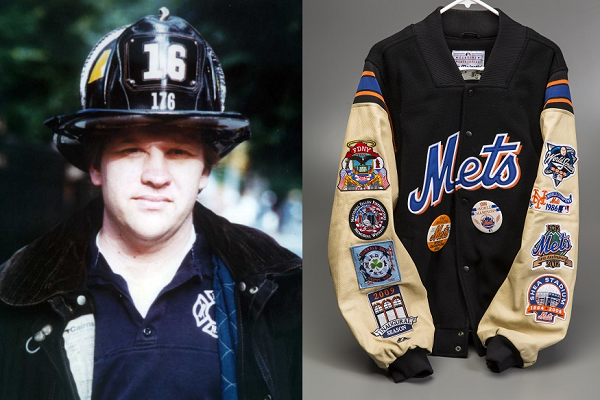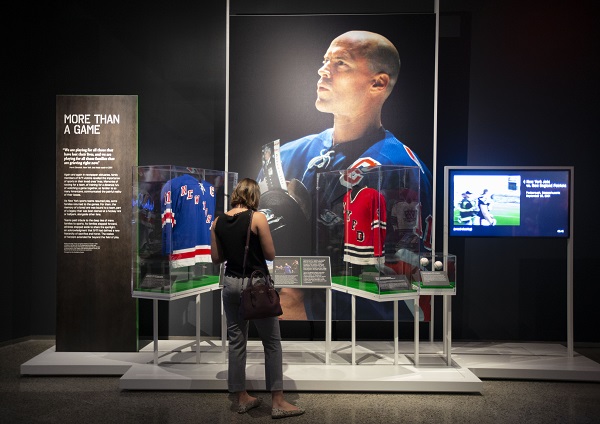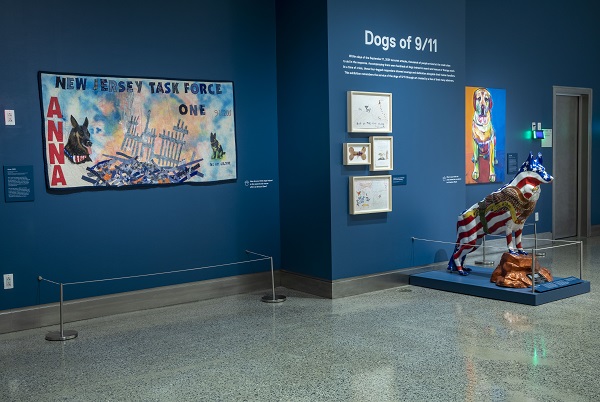Make a donation to the museum
Mets Jacket Details FDNY Lieutenant’s Professional Accomplishments
Mets Jacket Details FDNY Lieutenant’s Professional Accomplishments

Hailing from Maspeth, N.Y., FDNY Lt. Kenneth (“Kenny”) John Phelan was true to his Queens roots, especially when it came to his unwavering loyalty to the borough’s beloved baseball underdogs, the Mets. His mother Helene recalls how at age five, her son once wore a New York Mets uniform – day and night – for a week straight.
Growing up, he and his five siblings would cut out Mets coupons from Borden’s milk cartons. Kenny would then go to Shea Stadium to redeem tickets for everyone. On his first date with Patricia, the high school sweetheart who became his eventual wife, Kenny invited her to a Mets game. Almost as if on cue, the Mets won that night, and when Patricia reflected on that poignant memory years later, she said, “I guess I won too.”
In 2013 Kenny’s sister and brother-in-law, Mary and Charles Cox, donated a Mets jacket in his memory to the 9/11 Memorial Museum. The colorful patches and pins that adorn the jacket tell entwined stories of triumphs: Kenny’s rise within the FDNY alongside memorable moments in the history of the team he adored.
Adding patches to the jacket originally began as a way to mark various milestones for the Mets – such as the team’s 1986 World Championship victory. After 9/11, however, Mary and Charles decided to transform it into a wearable tribute to Kenny and his legacy. The result is deeply personal as well as unique, providing insights into Kenny’s career and his motivations for joining the FDNY.
There are three patches sewn onto the back of the jacket. The one at the top transports us to Engine 16/Ladder 7 and back to 1989, when Kenny began his firefighting career at this midtown Manhattan firehouse. It was with this company that he responded to the first terrorist attack on the World Trade Center on Feb. 26, 1993, helping to evacuate people to safety.
The patch below it on the left holds particular personal significance. It is from Engine 217 in the Bedford-Stuyvesant section of Brooklyn, where Kenny’s father had served for 20 years as a New York City firefighter. It was one of Kenny’s aspirations to work at this firehouse in honor of his father, and it was there that he would earn the prestigious rank of lieutenant. His sister recalled that as a boy, Kenny often tagged along when their father went to work at Engine 217 and even accompanied him on several runs.
The third patch on the jacket commemorates Kenny’s final ride with Engine 207/Ladder 110 on the morning of Sept. 11, 2001. That Tuesday, he had been filling in for another officer when the alarm sounded, calling the company to the World Trade Center.
After 9/11, Mary and Charles Cox took turns wearing the jacket in the bleachers of Shea Stadium while attending Mets games and the annual 9/11 anniversary observances at Ground Zero. Wearing it allowed them to channel Kenny’s spirit, keeping him close as they watched the ups and downs of the Amazin’ Mets. In 2013, they entrusted the jacket to the 9/11 Memorial Museum in tribute to Kenny’s life, legacy and boundless loyalty to his hometown baseball team.
By Alexandra Drakakis, Associate Curator, 9/11 Memorial Museum
Artifacts like Kenny’s Mets jacket are currently on view in “Comeback Season: Sports After 9/11,” and tell the story of how sports and athletes helped to unite the country, consoled a grieving nation and gave us a reason to cheer again following the 2001 attacks. Reserve your ticket here.
Previous Post
As America Grieved, Sports Helped Console a Nation

Since the special exhibition “Comeback Season: Sports After 9/11” opened at the 9/11 Memorial Museum in June, museum visitors have gotten a chance to revisit the unifying power of sports in the days, weeks and months following the 9/11 attacks.
Next Post
American Kennel Club Praises New Exhibition of “Dogs of 9/11”

Within days of the September 11, 2001 terrorist attacks, thousands of people arrived at the crash sites to aid in the response. Accompanying them were hundreds of dogs trained in search and rescue or therapy work. At a time of crisis, these four-legged responders showed courage and dedication alongside their human handlers.